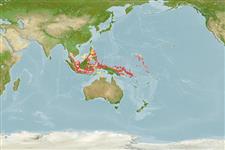>
Ophidiiformes (Cusk eels) >
Dinematichthyidae (Viviparous brotula)
Etymology: Diancistrus: Greek, di = two + Greek, agkistron = hook (Ref. 45335); altidorsalis: Name from Latin 'altus' meaning high and 'dorsalis' meaning neck, referring to its high-necked profile..
More on authors: Schwarzhans, Møller & Nielsen.
Environment: milieu / climate zone / depth range / distribution range
Ekologi
laut berasosiasi dengan karang; kisaran kedalaman 15 - 20 m (Ref. 57884). Tropical
Western Pacific: Indonesia, New Guinea, Sabah to the Solomons, including Sta. Cruz Islands.
Size / Weight / umur
Maturity: Lm ? range ? - ? cm
Max length : 10.2 cm SL jantan/; (Ref. 57884)
deskripsi pendek
Morfologi | Morfometrik
duri punggung lunak (Keseluruhan (total)): 76-85; Sirip dubur lunak: 59 - 68; vertebrata, bertulang belakang: 43 - 45. Diagnosis: Vertebrae 11+32-34=43-45, dorsal fin rays 76-85, anal fin rays 59-68; eyes large (at least 2.5% SL); outer pseudoclasper large, broad, ear-lobe shaped; inner pseudoclasper a fleshy appendix at the anterior-inner rim of the outer pseudoclasper, without supporter; large scale patch on operculum above opercular spine (6–9 scales) and 1 to 3 isolated scales below opercular spine; head profile strongly ‘high-necked / hump-backed’; color yellow in live specimens (Ref. 57884).
Large dominating individuals were observed to make attacks toward smaller fish, which were hiding below rocks or any other shelter provided. One male was observed to flip backward the cover of the copulatory organ so that the organ can be exposed while swimming (Ref. 57884). Solitary inhabitant of coral reef crevices to at least 20m depth, cryptic (Ref 90102).
Life cycle and mating behavior
Kematangan | Reproduksi, perkembang biakan | Pemijahan | telur-telur | Fecundity | Larva
Schwarzhans, W., P.R. Møller and J.G. Nielsen, 2005. Review of the Dinematichthyini (Teleostei, Bythitidae) of the Indo-West-Pacific. Part I. Diancistrus and two new genera with 26 new species. The Beagle, Records of the Museum and Art Galleries of the Northern Territory 21:73-163. (Ref. 57884)
Status IUCN Red List (Ref. 130435)
ancaman kepada manusia
Harmless
penggunaan manusia
informasi lanjut
Nama-nama umumSinonim (persamaan)metabolismePemangsaEkotoksikologiReproduksi, perkembang biakanKematanganPemijahanSpawning aggregationFecunditytelur-telurpekembangan telor
Umur / SaizPertumbuhanpanjang-beratpanjang-panjangukuran frekuensiMorfometrikMorfologiLarvaDinamika larvapemulihanKelimpahanBRUVS
AcuanBudidaya airprofil budidaya airStrainGenetikaElectrophoresesDiturunkanPenyakit-penyakitPengolahanNutrientsMass conversion
mitraGambarStamps, Coins Misc.Suara-suaraCiguateraKecepatanTipe renangArea insangOtolithsOtakPenglihatan / visi
Alat, peralatan
laporan khas
muat turun XML
Sumber internet
Estimates based on models
Preferred temperature (Ref.
123201): 27.9 - 29.3, mean 28.8 °C (based on 1452 cells).
Phylogenetic diversity index (Ref.
82804): PD
50 = 0.5000 [Uniqueness, from 0.5 = low to 2.0 = high].
Bayesian length-weight: a=0.00389 (0.00180 - 0.00842), b=3.12 (2.94 - 3.30), in cm total length, based on all LWR estimates for this body shape (Ref.
93245).
Trophic level (Ref.
69278): 3.4 ±0.5 se; based on size and trophs of closest relatives
Fishing Vulnerability (Ref.
59153): Low vulnerability (10 of 100).
